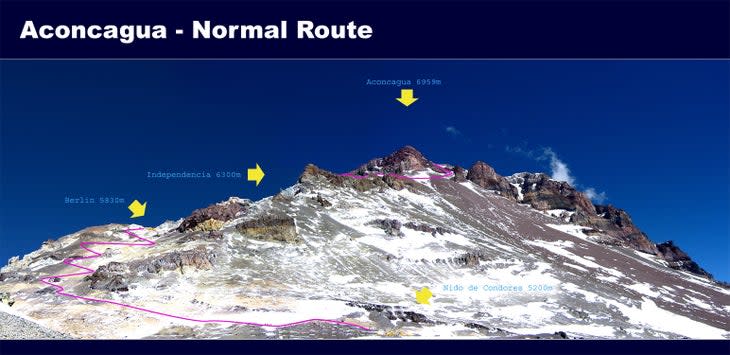Aconcagua, The Americas’ Highest Mountain
This article originally appeared on Climbing
This article is part of Climbing's online archives documenting climbing's greatest mountains, such as Everest, and its pioneering practitioners such as Marc-Andre Leclerc.
Aconcagua (22,838 feet) is both the tallest mountain in the Americas and the highest mountain in the world outside of Asia. Located near Argentina's border with Chile, 70 miles northwest of Mendoza, Aconcagua is also the second most topographically prominent peak in the world, after Mount Everest (8,848 m/29,031 ft). The origins of the name Aconcagua are debated, but believed to have originated from the indigenous Quechua ackon cahuak, meaning "stone sentinel," or the Aymara janq’u q’awa, meaning "white ravine."
Via the standard route, Aconcagua is considered a relatively safe climb for its height, with no crevasse risk, no ep/technical pitches, and no other hazards commonly encountered on other mountains of similar elevation. Despite standing almost 23,000 feet high, for much of the year Aconcagua is relatively snow-free, and increasingly so in recent years due to climate change.
As a result, Aconcagua is oft-considered the highest "trekking peak" in the world. Although not a technical climb (by the standard route), Aconcagua's high elevation, geographic location--far south from the equator and close to the ocean--and status as one of the "Seven Summits" means that it's an extremely popular mountain, especially for novice mountaineers.
The peak sees approximately 3,500 prospective climbers each year. This high traffic, coupled with the inexperienced nature of many prospective climbers, means that despite its low technical difficulty and relative safety, Aconcagua sees more fatalities than any other major peak in South America. The peak has at points also dealt with a significant human waste problem.

History
Aconcagua was first attempted in 1883 by German geologist Paul Gussfeldt, making a high point of 21,300 feet after two attempts via the Northwest Ridge (now the "Normal Route"). In 1897, a team led by British mountaineer Edward Fitzgerald made the first recorded ascent. Fitzgerald was a skilled climber, with extensive experience in New Zealand's rugged Southern Alps, and though he failed to reach the summit himself--despite making half-a-dozen attempts--a Swiss guide in his party, Matthias Zurbriggen, summited alone on January 14. Two other expedition members reached the summit a month later in a subsequent attempt.
At the time, Aconcagua was the highest climbed peak in the world. However, William Woodman Graham's claim of climbing Kabru (24,111 ft) in the Himalaya in 1883 (if true) would instead take the prize, though Graham’s claim is generally regarded as bunk.
A six-man Polish team made the first ascent of Aconcagua via the east, on what is now know as the Polish Glacier route, on March 4, 1934. Up until this point, all ascents of the peak took the standard route on the northwest ridge. Aconcagua was not climbed in winter until 1954, when a trio of Argentine climbers reached the summit via the Normal Route between September 11 and 15.
Today, Aconcagua's relative safety and accessibility makes it the site of a number of altitude records and attempts. The world's highest contemporary art gallery--Nautilus--is located on Aconcagua inside a tent in the Plaza de Mulas basecamp at 14,100 feet. Nautilus features the works of post-impressionist Argentine painter Miguel Doura. Among other recent records, Czech ultrarunner Martin Zhor set the fastest known time from Plaza de Mulas to the summit, ascending in a mere three hours, 38 minutes in December 2019.
Aconcagua is also the site of significant archaeological discoveries dating to the Inca period. In 1985, a mummified seven-year-old boy--the victim of a human sacrificial practice known as Capacocha--was discovered at 17,400 feet on the mountain, inside a semicircular stone structure along with a number of grave goods. The burial site, an estimated 500 years old, is among the highest archaeological sites in the world.
Climbing Routes
There are two main routes on Aconcagua, the Normal Route and the Polish Glacier. The Normal Route is the easier, and more popular, of the two. Ascending the peak's northwest ridge from the valley of the Rio Horcones--the Normal Route is a relatively straightforward walk-up, with no technical sections or objective hazards save for the altitude and weather. The Polish Glacier is significantly harder, with 50- to 70-degree snow and ice slopes requiring ropes and protection.
Besides the Normal Route, most parties use the Polish Traverse, a combination of the Polish Glacier and Normal Route, which is also referred to as the False Polish or 360deg Route. This line offers a bit more variety than the standard route, without the technical climbing of the Polish Glacier, and is the second-most popular line on the peak. Although there are no permanent snowfields on the Polish Traverse or the Normal Route, there is sometimes ice and/or hard-packed snow, so crampons and ice axes may be required depending on conditions.
Most climbers attempt Aconcagua between November and March, with a high season of December and January. Regardless of the route chosen, Aconcagua is a high-elevation summit and there are accidents and deaths every year, most often from exposure, altitude, or a combination of the two. It might be the easiest climb for a peak of its elevation, but it should never be underestimated. Many consider Aconcagua an excellent starting point for high-altitude mountaineering, giving one a taste of the conditions encountered on 8,000-meter climbs in the Himalaya or Karakorum.
Facts and Figures
Elevation: 22,838 feet
Range: Andes
First ascent: January 14, 1897
First ascentionist: Matthias Zurbriggen
Annual attempts: 3,000 to 4,000
Average success rate: 30%
Average death rate: 0.3%
Average cost to climb: $7,500
Also Read
For exclusive access to all of our fitness, gear, adventure, and travel stories, plus discounts on trips, events, and gear, sign up for Outside+ today.

